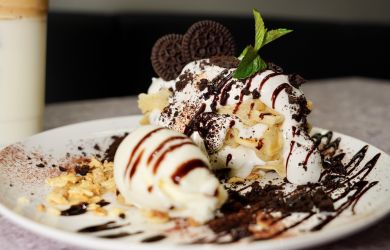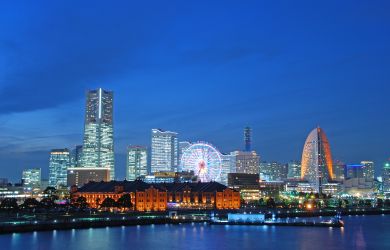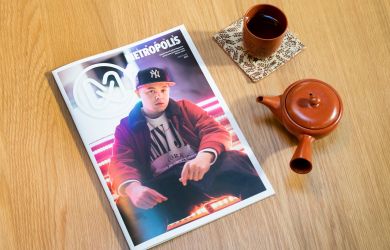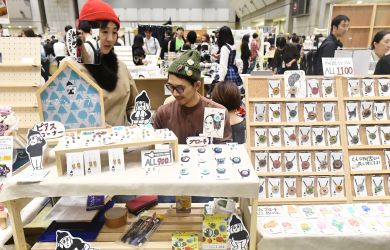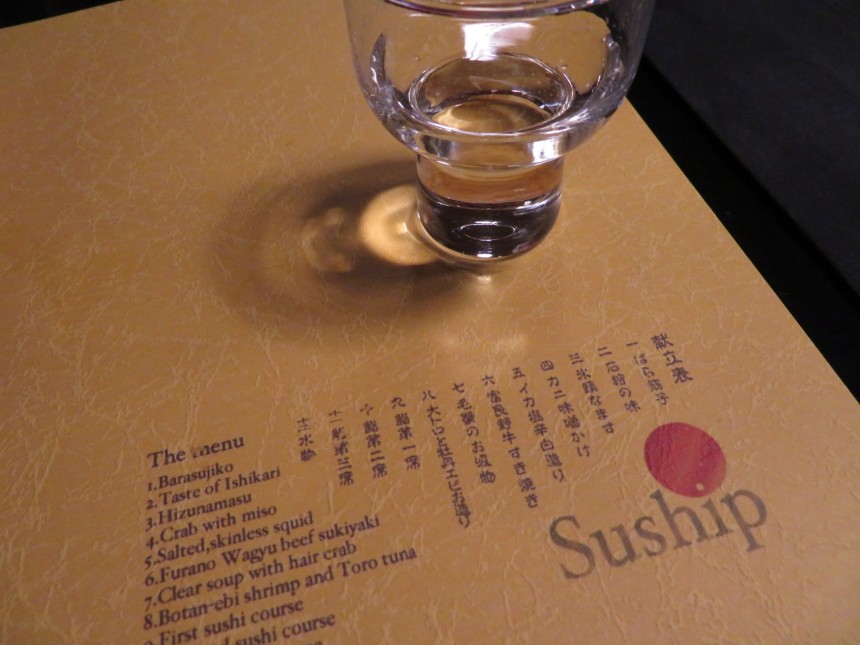
During the Edo Period (1615-1868), a concept and imagined universe entitled ukiyo, or “the floating world”, made its way throughout the country. Within the growing urban centers of Edo, Kyoto and Osaka, the idea represented the common people’s desires to spend their time being entertained, as the rich and elite did. To the simpler countryfolk that lived far away from the prospering cities, the idea came to represent a near mystical vision of luxury and extravagance the early city-dwellers of Japan experienced. Ukiyo-e was born of this image, the art form dedicated entirely to depicting images of the “floating world.”
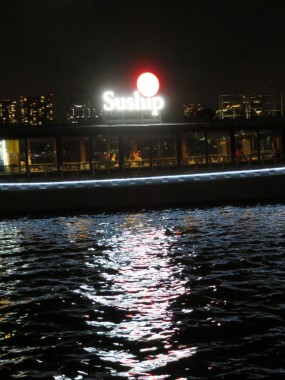
There may be less blind reverence and artistic admiration for the lives of those who mingle within “the floating world” today, but on the other hand, there is a much more accessible “floating world.” This newer concept also espouses an appreciation for the finer luxuries and forms of entertainment in life, but it comes in the form of an excellent ten course meal served in a stylish atmosphere aboard a small ship afloat in Tokyo Bay.
In sight of the Rainbow Bridge and the sparkling lights of Odaiba, the floating restaurant called “Suship” (the obvious portmanteau of “sushi” and “ship”) serves a ¥10,000 set menu meal dominated by seafood sourced from Hokkaido.
Diners are picked up at a boat landing near Kachidoki Bridge for a 10-15 minute ride down the Sumida River, reaching Suship shortly after passing under the Rainbow Bridge. The ride is a visual aperitif, allowing expectations of the experience ahead to build up.
From the outside, Suship looks like many other yakata-bune dinner boats, but inside, it has Western-style seating that can fit a maximum of 36 diners. Tatami flooring and woven bamboo on the ceiling keep the room quiet no matter how crowded with guests it might be. The lovely space, the elegant atmosphere, the fantastic water views—it’s easy to imagine this as a great spot for a romantic dinner.
You’ll find the appetizer already laid out and waiting at your table, but before picking up your chopsticks, take in the view. You’re sitting close to the water, with city lights in the distance and their reflections twinkling in the undulations of the bay.
The appetizers consist of a number of small seafood dishes, cleverly contained in two tiers of a semi-circular jubako. It’s hard to know where to begin. About the same time as you have made your decision and begun to sample crab or squid or salmon roe (to name a few of the appetizers), the waiting staff light a small lump of cooking fuel below a pot containing all the ingredients for an individual serving of sukiyaki (thin slices of beautifully marbled beef), which takes center stage. As the broth heats, the beef and the vegetables that surround it begin to cook and soon the entire dish is happily bubbling away. By now, you’re worked through the seafood appetizers—or most of them, at any rate—and are ready to enjoy the freshly cooked sukiyaki.
To complement your meal, consider adding the drink package. Right now, the restaurant is offering the unlimited package for just an additional ¥1,200—how can you beat that? In some restaurants the house “vintage” is questionable, but in this case, the sake served is an excellent complement to each course of the meal.
After sukiyaki, the next course is a delicate clear soup with a joint of crab legs, the flesh juicy and delicious once you’ve extracted it. Next comes shrimp and toro tuna sashimi, with the usual condiments to be added to the soy sauce. The succulent sashimi literally melts in your mouth.
Following this, three plates of sushi are served, one at a time. First come four pieces in Edomae-style sushi, accompanied by thin slices of gari ginger pickles. The second plate carries two pieces of nigiri sushi, one halibut and one raw octopus, each topped with a small dot of pink (grated radish with some pink mustard for color) to make the white fish look like little Japanese flags. Apparently octopus needs to rest a couple of days to make it tender enough to be eaten completely raw.
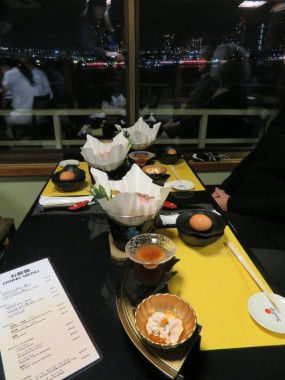
The last plate of sushi includes oshizushi which has been pressed in bamboo for a couple of days, as well as an uncut tuna roll (the waitress recommended using fingers to eat it) and even a California roll.
By this time, you’ve been stuffed; this is a big meal. Fortunately, the dessert is light, a few pieces of jelly-like warabimochi dusted with matcha powder; a perfect end to a memorable meal.
Throughout this delightful meal, enjoy views of the bay, neighboring dinner boats and the lights of the city. If you feel up to it, take a breather on the boat’s roof and relax to the slow ocean breeze while you take in the spectacularly expansive view in every direction. It is the perfect cap to an amazing dining experience.
Suship offers hourly seatings from 5pm until late (make online reservations here). From the time of pick up at Kachidoki Bridge (about a 7-8 minute walk from Tsukiji Station) to the time you are returned to the same spot, the escape is about three hours. It is a fantastic evening in the floating world of fine dining.
